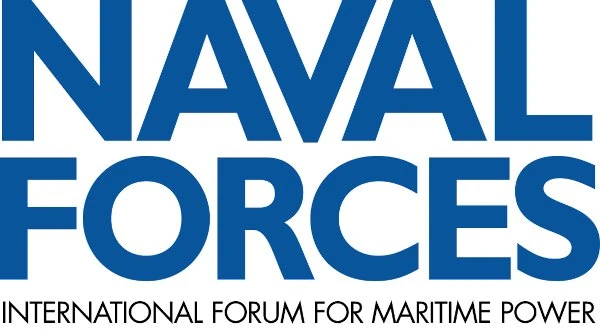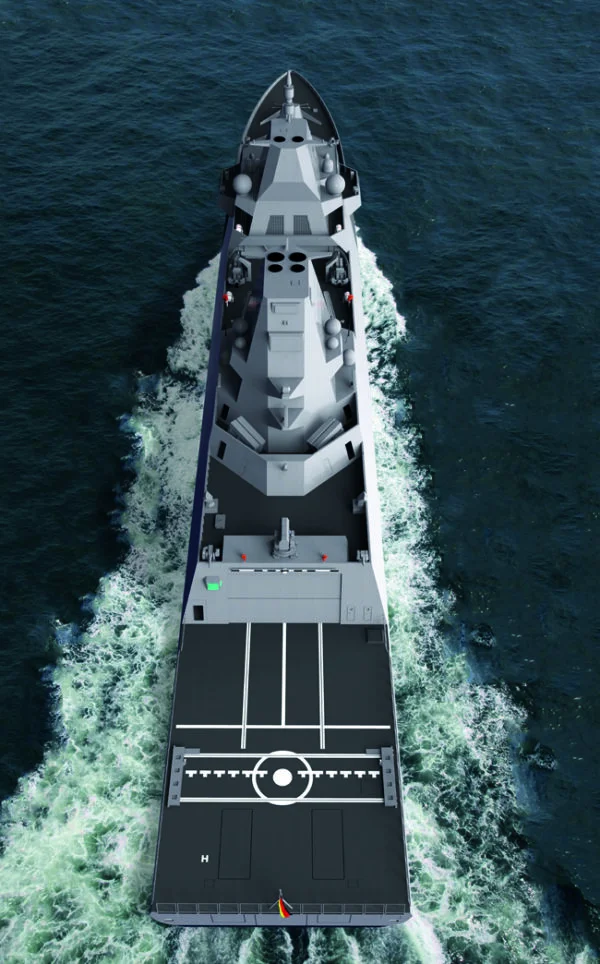The propulsion systems of especially German frigates had lately seen a trend to ever increasing complexity.
Interview: Christoph Fenske
Photos: Damen Naval; NVL Group
Although these are very capable systems, the trend towards smaller, less skilled crews led to a need for simpler, yet flexible and highly automated propulsion systems. With the F126 frigate, the German Navy is introducing a number of innovations to the world of ship propulsion. Naval Forces spoke to the project manager of the German BAAINBw procurement office, Rudolf Braun, about the reasons for and advantages of this quite unconventional approach to frigate propulsion.
Naval Forces: Can you give an overview of the propulsion system used in the frigates of the Type F126 frigates? How does it differ from conventional frigate propulsion systems and what advantages does it offer?
Rudolf Braun: The propulsion concept of the Class 126 frigates is based on a CODELAD propulsion system. CODELAD stands for Combined Diesel Electric And Diesel. Two independently operating shafts provide the propulsion power. On each shaft train, a propulsion diesel engine and an electric motor can deliver the power to the shafts individually or together. This eliminates the need for the complex and high-maintenance combining gearboxes that were previously required. The use of medium-speed propulsion diesel engines is also a novelty on German Navy frigates. In addition, the electric motors can also be used as generators to produce electricity in power take-off mode, which reduces the operating hours of the power generators, among other things.
Naval Forces: The F126 frigates have a hybrid power and propulsion system (power & propulsion; P&P). Could you explain how this hybrid configuration improves the ships’ operational capabilities, particularly in terms of efficiency, versatility and signatures?
Rudolf Braun: In addition to the propulsion engines, the new frigate has four diesel-powered gensets whose power is fed into a battery-buffered DC [direct current] grid. This ensures stable grid operation and fast response times in the event of changing load requirements. By using the DC grid, the generating sets can feed power into the grid independent of frequency and speed, which enables operation at the optimum operating point and thus significantly increases the efficiency of the system. The power generation units are encapsulated and integrated into the ship using structure borne noise reducing mounts, thus ensuring a reduced acoustic signature during operation. As the electric motors are also fed from this direct current network, there are advantages in terms of the stable operation of these motors. This in turn has a positive effect on the versatility and effectiveness of the ships and increases the possible uses of the ships.
Naval Forces: What considerations were crucial for the decision to equip the frigates of the F126 frigates with a CODELAD propulsion system? How does this propulsion system contribute to the ships’ performance in a range of operational scenarios?
Rudolf Braun: The Class 126 frigates are capable of three-dimensional naval warfare across the entire intensity spectrum and for worldwide deployment. As a modular, maritime capability platform, the F126 has basic capabilities that meet its permanent operational obligations. These include, above all, the ability to lead a maritime task force and the possibility of self-defense, as well as the ability to engage sea and air targets. The new ships will provide a platform with a capability focus on large-scale submarine hunting to protect task forces and sea areas. Thanks to its mission modularity, the requirements of other operations and missions can also be covered. Specifications for intensive use of up to two years in operation and a significant reduction in crew numbers compared to units already in service require a high degree of automation of the ships.
Naval Forces: A robust propulsion system, such as the CODELAD propulsion system of the F126, is therefore a basic prerequisite for meeting these requirements. Redundancy is of the utmost importance in naval operations. How does the CODELAD propulsion system improve the reliability and survivability of the F126 frigates, particularly in terms of mitigating the effects of mechanical failure or damage to propulsion components?
Rudolf Braun: The F126 frigates are subject to increased requirements in terms of robustness and redundancy. For example, if one system fails, a second system must always be available to take over the tasks of the failed system. In the propulsion system, this is achieved on the one hand by two independently operating propulsion shafts and on the other hand by two electric motors on each shaft. In addition, the propulsion system only has single-stage reduction gears of a simple design, which also reduces the likelihood of damage to drive components.
Naval Forces: Could you explain the role of advanced control and automation systems in optimising the performance of the P&P system of the F126 frigates? How do these systems contribute to efficient power management, propulsion system management and overall operational efficiency?
Rudolf Braun: The implementation of an advanced control and automation system on the Class 126 frigates contributes to ensuring the intensive use concept and reducing crew numbers. Automatic and fast control processes are essential for the performance and endurance of the frigates. In addition, advanced technologies, such as the battery-buffered DC network, require computer-aided control processes in order to develop their full potential. The automatic switching on and off of power generation units depending on power requirements and the automated status monitoring of the battery systems are just two aspects of the efficient and intelligent energy management on board the new frigates. The full performance of the system is clearly visible in combination with a sophisticated propulsion plant automation system and a higher-level command and control system.
Last but not least, a well-trained ship’s crew in the operation of the automation system and training facilities implemented for this purpose also contribute to efficient ship operation.
Naval Forces: Maintenance and repair are crucial aspects of the operation of naval vessels. What measures have been taken to improve the reliability, maintainability and cost efficiency of the P&P system of the F126 frigates over the entire service life, and what supporting infrastructure is in place to available to meet maintenance and repair needs?
Rudolf Braun: The capability of the F126 frigates for intensive use results in corresponding requirements for operational availability. It must therefore be demonstrated through calculations on reliability, availability and maintainability on the basis of the current system breakdown that preventive maintenance tasks on board can be carried out within the specified daily, weekly and monthly working hours. The maintenance concept of the F126 is structured in such a way that the system is kept in an operational condition while carrying out regular preventive maintenance with the existing on-board personnel.
With the help of remote support, communications and data channels are created to support the crew and maintenance personnel in carrying out maintenance work. Maintenance and repair work is carried out exclusively by authorized and trained personnel on the instructions of the ship’s command on the basis of the interactive documentation supplied and the maintenance documents. The remote support has only an advisory function. For further support, reference systems are provided in the naval arsenal and at the navy, so that the possibilities of remote support and maintenance and assistance through the services provided can also be used there to the same extent as on board the units.
Furthermore, a comprehensive condition monitoring system is planned for the ship automation system, which will be used to analyze the condition of a system and create an expected trend.
Naval Forces: Sustainability, emissions and the scarcity of fossil resources are also the subject of much discussion in the naval world. How and to what extent did the German Navy take these aspects into account when developing the F126’s energy and propulsion system?
Rudolf Braun: The Class 126 frigates comply with the emission requirements of IMO Tier III issued by the International Maritime Organization and therefore already meet the emission regulations expected in the future in the global area of operation. To this end, the ships are equipped with exhaust gas treatment systems for the propulsion diesel engines and the diesel engines for power generation. The Class 126 frigates also comply with the international convention for the prevention of marine pollution from ships, the MARPOL Convention, by using low-sulphur fuels and complying with the fuel discharge limit by using smaller bunkers.
Furthermore, the operating hours of the diesel generators are reduced by the efficient P&P system, which, together with the fact that the generators can be operated independently of speed, leads to a considerable reduction in emissions and fuel consumption. In addition to the environmental protection measures in the propulsion system, additional measures to protect the environment are taken in a number of other technical ship systems, such as ballast water treatment.
Furthermore, extensive analyses of ship emissions serve to identify organizational measures to protect the crew from pollutants.
Naval Forces: Looking to the future, alternative, i.e. non-fossil fuels are being discussed as a way to move NATO and allied countries away from critical source countries. What is the German Armed Forces’ plan to address these issues further?
Rudolf Braun: The introduction of new, innovative technologies into the Bundeswehr plays a major role in large, new naval newbuilding projects. In the case of the Class 126 frigates, for example, the advanced automation system serves to ensure the most efficient operation possible. This is just one example in a large portfolio aimed at reducing the logistics footprint. The Bundeswehr will continue to keep its finger on the pulse by carrying out investigations in the field of defence research and technology. This also applies to the investigation of alternative fuels and innovations in the area of propulsion systems for naval vessels.
However, the military mission is paramount, which means that the factors of stability, global supply capability and power density of the system must always be taken into account.









